Here at Lady Kentmores we like to embrace the dark side of antiques and curios, We especially love
Taxidermy and Vintage Medical Items.
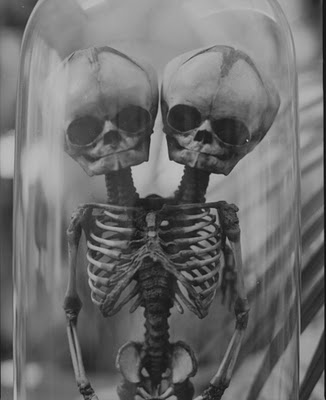
I suppose it's because of my heritage, my grandparents owned a travelling freak show and a fairground ghost train that I inherited a love of all things strange. It is because of my love of these items that here at Lady Kentmores we have became known as one of Scotland's leading purveyors of oddities and curios.
So whether you are looking to buy or sell any items that might fit in this category or even if you feel what you are looking for or might have to sell is too strange, don't worry as we have seen it all from stuffed polar bears and dentist chairs to skeletons .
Call us today for more information
01877 339835

Don’t Get Stuffed by Taxidermy
By George Johnson
Sometimes being an antique dealer means having to handle items that you may not choose to own personally, there is nothing wrong with having your own morals, as a matter of fact I take a great dislike to the trade in WWII German items. This is because of my own family background and how my ethnic minority was treated during this terrible time.
Putting this aside we still need to acknowledge that there may be trade or collectors in areas where we may not a be particularly comfortable with, one such area that I personally come across regularly is the trade in Antique Taxidermy and Antler Items this is mainly because I have a Antique shop in the rural Scottish Highlands. I see a lot of this type of antiques on a weekly if not daily basis. Trade in this area can be a bit confusing for those people who are not aware of the rules and regulations that govern the sale and ownership of these items, so although I do not want to glamorize items of this nature I will explain the market and also the regulations in these objects.
The Golden era of Taxidermy was said to be between the years of 1860 and 1920. The Victorian fascination with the subject fuelled a desire for museum quality specimens displayed in elaborate cases and set in realistic natural poses. However changing tastes lead to a sharp decline in trade by the end of the First World War. Most towns up to this period had a resident Taxidermist although there was a lot of top class professionals in the field of taxidermy there are still many strange items around as some of these smaller town professionals never actually saw the more exotic animals in their natural environment so it lead to some very unnatural and almost comical poses.
Some of the most famous of taxidermists of this period of history are;
Walter Potter (2 July 1835 - 21 May 1918) who is one of the most well known of the English taxidermists of the Victorian period, he created his own museum where he displayed his works. His speciality was to display animals in human poses and situations. The "Kittens' Wedding" scene which was one of the very last pieces of taxidermy that he created in 1890 was exhibited in 2001 as part of the ‘Victorian Vision’ exhibition which was held by the Victoria and Albert Museum.
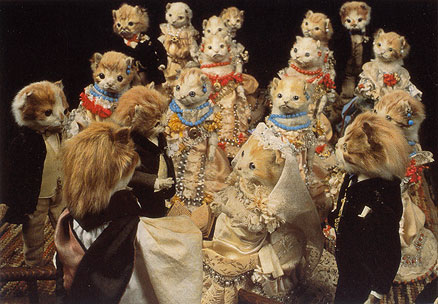
Potters collection was displayed in his museum which was kept going until the 1970’s at which point the collection changed hands several times before it was finally auctioned by Bonhams on the 23 and 24 September 2003 at the Jamaica Inn in Bodmin Moor, Cornwall which was the last place that the collection had been on public display. The collection ended up selling for a total of £529,900 which was more than twice the predicted sum that Bonhams had estimated. The Kittens wedding which had been exhibited by the Victoria and Albert two years before was sold for the grand sum of £21,150.
This was not however the end of the story as controversy clouded the auction when it came to light that Damian Hirst had offered a bid of £1m to save the collection being broken up into smaller lots. However the Auctioneers had apparently rejected this bid. The owners were very angry at this and sued Bonhams, arguing that this offer should have been accepted.
About the auction, Hirst said, "I've offered £1m and to pay for the cost of the auctioneer's catalogue - just for them to take it off the market and keep the collection intact - but apparently, the auction has to go ahead. It is a tragedy."
Another British Taxidermist whose name crops up regularly in sale rooms up and down the country is Rowland Ward (1848-1912) who founded the famous Piccadilly based taxidermists Rowland Ward Ltd. But Wards type of taxidermy was in a very different style to the aforementioned Walter Potter, Wards speciality was the more traditional style of big game trophies .He was trained in the art of taxidermy by his father so had a very traditional education in this art form. His father Henry Ward was also a very highly regarded individual in the field of taxidermy; Henry had travelled extensively and even worked with John James Audubon collecting and preparing specimens for the artist. Which were later used in the book Birds of America. The Economist magazine has suggested that when adjusted for inflation, five of the ten highest prices ever paid for printed books were paid for copies of Birds of America. There are only a 119 copies of the book known to have survived and only 11 of these are still in private collections so when they do come onto the market they can fetch amazing prices.
On 7 December 2010, a complete copy of the first edition of Birds of America was sold in London at Sotheby's auction house for £7,321,250 the interesting fact about this sale was that it had originally sold at a Christie's auction on the 3 July 1951 for a price of £7,000.
So if you are thinking of buying or selling any taxidermy what are the rules on ownership and the sale of items? Well a lot of people will just quote the date 1/6/1947 without elaborating but what is the meaning of this date? at the very heart of the rules is CITES this is an abbreviation that often crops up when people talk about taxidermy it stands for The Convention on International Trade in Endangered Species of Wild Fauna and Flora, this is an international agreement that was made between various governments during the 1960’s and its main aim was to ensure that the international trade in specimens of wild animals and plants does not threaten the survival of any individual species. The agreement covers many different areas including the trade in many types of products including such items as fur coats, taxidermy, exotic leather goods, wooden items as well as the trade in live animals and plant life the rules actually govern the trade in over 30,000 species of animals and plants so as you can imagine with a remit so wide and varied the legislation and rules can be very daunting.
The trade in animals in the European Union is divided up into four main groups under the Commission Regulation 709/2010 the list is to wide and complex to list within this article but further information on individual types of animal and what group they fall within can be found at www.defra.gov.uk
Most items of taxidermy that is found in auction rooms around the country are found within category ‘A’ If an item of falls within this and has been worked before the 1/6/1947 date which means in simple terms items like a hoof that was turned into an inkwell or a head that has been mounted on a shield also some simple maintenance can have been carried out like rips or breakages repaired after this date but things like missing teeth cannot have been replaced with a modern set from another animal after the 1947 cut off date and the item is not to be changed in appearance so you can’t take a rug with a head and cut it off and mount it as this would make the item illegal. One other area that is very important is the ability to prove that the item was worked before 1947 so provenance is a very important thing, some named pieces of taxidermy can be dated by the makers name and marks but it is always best to have pieces verified by an expert.
If an item is an un worked piece such as a un-carved whales tooth this does not meet the criteria and is classed as illegal and cannot be dealt in, but if it has been carved (Scrimshaw) it is then worked and legal to trade but just to complicate matters if it was carved after 1947 it would also be illegal.
There are some items that are controlled by stricter rules one of these that has been in the spotlight in recent months is the trade in Rhino Horn the new regulations have been put in place to try and stem the market that has been fuelled by the illegal trade in Far Eastern homeopathic remedies. The new rules have banned the export of Rhino Horn in most cases the only exceptions are;
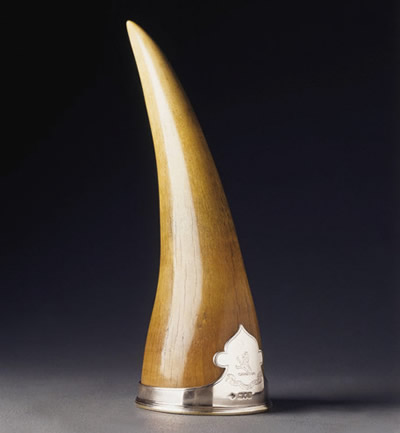
* The individual item is of such artistic value that it exceeds its potential value on the illegal medicine market.
* The item is part of a genuine exchange of cultural goods between reputable institutions (i.e. museums).
* The item has not been sold and is an heirloom moving as part of a family relocation.
* The item is part of a bona fide research project.
To trade in rhino horn within the UK any piece needs to have been worked so un-worked mounted rhino horn cups are illegal and cannot be traded in but any other item of rhino horn needs specific written clearance from the UK CITES Management authority. If a rhino horn is mounted on a plaque, shield or anything similar this would not qualify and as such is not allowed to be dealt in
A Chinese Rhinoceros Libation cup is a fine example of the type of item that is still allowed to be traded as long as it has the relevant paperwork. But they can fetch some very high prices as it was proved when an example that was beautifully carved with a dragon set among climbing foliage sold for £50000.00 in July 2010 at George Kidner Auctioneers of Lymington

So what is the state of the market in items of taxidermy well there are a few different sectors of taxidermy;
Fish are a popular and hardly controversial .Some of the largest fish that have been caught around the UK have ended up in the hands of a skilled taxidermist which has saved these specimens from becoming mere fables told by anglers. They are one of the hardest of animals to preserve as most lose their natural colour so need to be painted and this was a job of a very skilled professional. One method involves the removal of the skin and mounting it back onto a simple frame or form to keep the natural shape. Another was to take a mould of the fish and use this cast to make a replica. It is important to learn to recognise the difference.
The market in these taxidermy fish can be quite varied the highest prices are reserved for specimen fish including Salmon and wild trout that have been caught from famous rivers including the likes of the Spey, Dee, Tay or Tweed.

One very fine example of the plaster casting type of fish taxidermy is located at Glendelvine estate in Perthshire. It is also the heaviest recorded rod caught salmon and was landed by Miss Georgina Ballantine on October 7th 1922, she was fishing with her father who was the ghillie on the estate and after an epic battle she landed the Salmon that weighed an outstanding 64Ibs, a weight never likely to be beaten. The Taxidermy Firm of P.D Malloch’s made a cast of the magnificent creature and then the fish was sent to Perth Royal Infirmary where it was shared between the patients and staff.
Small Birds & Mammals this type of taxidermy is very common and appears very frequently in many auction rooms, unless an item of this type is of a rare or unusual of animal or has been created by a well known name in the field of taxidermy prices tend to be quite subdued with many specimens available for under £100.
Large Mammals & Other Taxidermy This category is probably the most controversial area in the field of taxidermy the mounted heads of big game animals are a subject that can cause heated debates but for the sake of this article we will not get tied up in the ethics of the subject.
The market can be very strong in this area with very good examples by well known Victorian taxidermist achieving very good prices.
Lion skin rugs with full taxidermy masks made by Roland Ward are very popular with collectors, one example was sold by Golding Young & Co of Grantham in November 2006 and reached a hammer price of £700
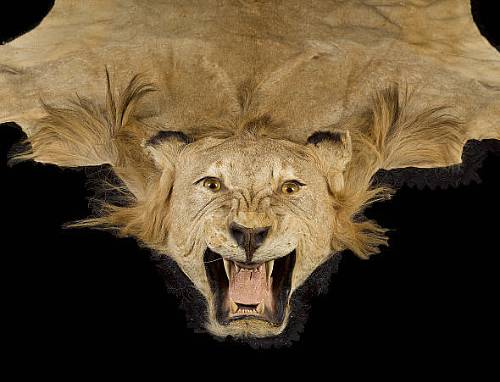
If you mention the word taxidermy to most people the image that usually comes to mind is taxidermy animal heads, most images of all country estates have one on a wall whether it is a large African game animal or a deer. One example of a Tigers head with an open mouth was sold by Charterhouse Auctioneers of Sherborne in April 2010 for a hammer price of £520
Antler is not really taxidermy but the market in it has become rather interesting as prices have risen steadily in recent years driven in part by the demand of antler to make walking sticks, pieces of jewellery and even designer chandeliers. High street chain Top shop has even installed designer antler chandeliers made by Johns Marsh in their New York and Oxford Circus stores, at one time Gamekeepers would leave antlers lying on the ground but they are now more likely to scour the countryside looking for it than leave it for people to pick up. The Price of antler has even reached a point where it is more expensive by weight than Venison.
Prices of antler used to be under £5 a kilo only a few years ago but today prices of over £10 a kilo are not unheard of.
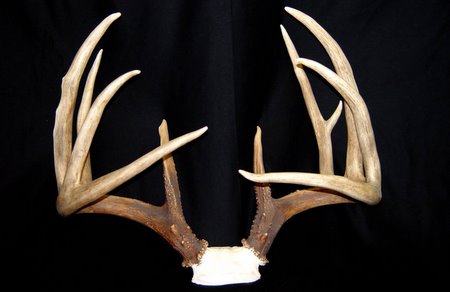
So as you can see the market in taxidermy can be complicated at times but prices can be outstanding, so by buying the correct item large profits can be made but always be aware that great losses are common to if you buy the wrong item.